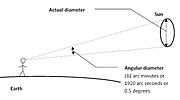R Doradus (HD 29712 or P Doradus) is a red giant variable star in the far-southern constellation Dorado, close to the border with Reticulum. Its distance...
16 KB (1,325 words) - 22:01, 12 September 2024
Betelgeuse (redirect from H. R. 2061)
Earth-observed angular diameter of Betelgeuse is exceeded only by those of R Doradus and the Sun. Starting in October 2019, Betelgeuse began to dim noticeably...
174 KB (18,522 words) - 03:33, 17 September 2024
S Doradus was still uncertain, considered possibly to be a pre-main-sequence star, but during the next decade the consensus settled on the S Doradus type...
28 KB (3,188 words) - 11:54, 31 August 2024
Tarantula Nebula (redirect from 30 Doradus)
The Tarantula Nebula (also known as 30 Doradus) is a large H II region in the Large Magellanic Cloud (LMC), forming its south-east corner (from Earth's...
14 KB (1,290 words) - 16:55, 22 June 2024
from the Sun, the star with the largest angular diameter from Earth is R Doradus, a red giant with a diameter of 0.05″. Because of the effects of atmospheric...
27 KB (3,338 words) - 06:41, 9 July 2024
lower temperatures but with radii reaching up to many tens of thousands of R☉, comparable to some of the largest known black holes. The angular diameters...
235 KB (10,236 words) - 10:01, 15 September 2024
a near-infrared J band magnitude of −2.2, only Betelgeuse (−2.9) and R Doradus (−2.6) are brighter. The lower output in visible light is due to a lower...
53 KB (5,320 words) - 15:41, 21 August 2024
distance D, expressed in arcseconds, is given by: δ = 206 , 265 ( d / D ) a r c s e c o n d s {\displaystyle \delta =206,265~(d/D)~\mathrm {arcseconds}...
26 KB (1,863 words) - 05:39, 23 August 2024
point source in most observations (the largest angular diameter, that of R Doradus, is 0.057 ± 0.005 arcsec), whereas a galaxy may extend over several arcseconds...
9 KB (1,079 words) - 17:33, 23 August 2024









